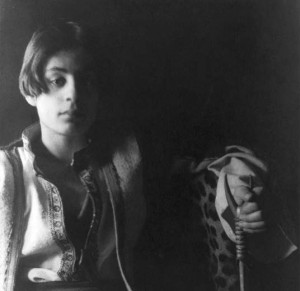
By Phoebe Moses
ANDOVER, MASSACHUSETTS — The elite Phillips Academy (Founded: 1778) is the scene for one of the most interesting photography exhibitions in the country, highlighting on one of the more eccentric figures of Americana of the past century. “Making a Presence: F. Holland Day in Artistic Photography” runs through July 31 at the school’s Addison Gallery of American Art. The exhibit’s subject, Fred Holland Day (1864-1933), was a photographer and publisher, and the most influential American “pictorialist”— the international style and aesthetic movement that dominated photography during the later 19th and early 20th centuries, which believed that the medium should number among the fine arts.
 Pictorialist photographers used what are now seen as rudimentary techniques to manipulate otherwise straightforward photographs, to “create” an image, rather than simply record it. Day was a wealthy Boston publisher, who apparently enjoyed playing dress-up and role-playing. He utilized props and costumes, and was something of a practitioner of a “Method School” style of photography, taking self-portraits that depicted him as Jesus Christ at the Crucifixion for an 1898 pictorial series. Day’s personality was many-layered.
Pictorialist photographers used what are now seen as rudimentary techniques to manipulate otherwise straightforward photographs, to “create” an image, rather than simply record it. Day was a wealthy Boston publisher, who apparently enjoyed playing dress-up and role-playing. He utilized props and costumes, and was something of a practitioner of a “Method School” style of photography, taking self-portraits that depicted him as Jesus Christ at the Crucifixion for an 1898 pictorial series. Day’s personality was many-layered.
In 1900, art critic Sadakichi Hartmann described him as “an extraordinary, extravagant personality,” and noted that, “To pose is a necessity to him, as it is only when he believes himself something out of the ordinary that he can accomplish good work.” That “necessity” was apparent in his numerous posings for both himself and other photographers. “Making a Presence” includes examples of Day acting out this need from the many stages of his life: As a 14-yearold boy, sporting a fake mustache in one early image, on through his masquerade as painter Rembrandt, for a 1901 portrait by friend Edward Steichen.
The photographer hit his stride at the end of the 19th and start of the 20th centuries. He was a firsthand witness to two separate cultural phenomena: the Aestheticism movement (best remembered through Oscar Wilde’s famous description of “art for art’s sake”), and photographic Pictorialism. In 1902, Day was able to show his devotion to both, at a show he held in Boston, titled “Portraits by a Few Leaders in the Newer Photographic Methods.”
The exhibition consisted of 54 photographs, which had been taken by 21 photographers, all concentrating on a single subject: Day himself. “Making a Presence” displays all 54 on a single wall. Day’s love for Symbolism, and for the Arts and Crafts movement, were equaled by his devotion to Pictorialism, which captured in many ways the very essence of how Day exhibited himself: Formal, romantic, stylized, and self-conscious.
That he used the camera—the ultimate hardware for chronicling reality—to capture fantasy was part of his vision. But his flirtations with the absurd are married to an innocence—almost a sweetness—that avoids the worst of campiness, and manages to convey true artistic sensibility. Not everyone at the time was impressed. The contemporary “Photographic News” considered Day’s work that “of a diseased imagination,” and believed that the Pictorialism movement was “fostered by the ravings of a few lunatics,” who proved themselves to be both “unacademic” and “eccentric.”
 Day became famous for his photographic portraiture of nude male subjects, and his work shows especial attention to African-American males. The homoeroticism in his work is crystal clear, and people can draw their own conclusions from his association with such contemporary figures as socialist philosopher, Fabian Society founding member, and early gay rights activist Edward Carpenter. Day’s assistance was likewise invaluable in helping another artist achieve lasting fame and cultural pride-of-place: Khalil Gibran, whom Day photographed in 1898, and who would become the third best-selling poet of all time (behind Shakespeare and Lao-Tzu).
Day became famous for his photographic portraiture of nude male subjects, and his work shows especial attention to African-American males. The homoeroticism in his work is crystal clear, and people can draw their own conclusions from his association with such contemporary figures as socialist philosopher, Fabian Society founding member, and early gay rights activist Edward Carpenter. Day’s assistance was likewise invaluable in helping another artist achieve lasting fame and cultural pride-of-place: Khalil Gibran, whom Day photographed in 1898, and who would become the third best-selling poet of all time (behind Shakespeare and Lao-Tzu).
Nearly 80 years after his death, Day has been largely forgotten. This was partly because he was eclipsed by his rival, photographer Alfred Stieglitz. The art world’s shift towards early Modernism also took its toll, as pictorial and symbolist photographic style went out of fashion. Too, the fact that 2,000 of his prints and negatives were lost in a 1904 fire didn’t help the legacy of this charming, and in some ways naïve, boy-man of a lost artistic form. “Making a Presence” runs through July 31.



